Over the next several months (3? 6? 10?) I'll be building what
is definitely my most complex electronics project to date: the MFOS
(Music From Outer Space)
Sound Lab Ultimate,
Ultimate Expander and (if Santa brings one)
Sound Lab Mini-Synth Mark II, likely all in the same home-made
wooden case, side by side. The Ultimate and Expander are together a
3 oscillator monophonic true analog synthesizer with filters,
envelopment generator, ring modulator, sample and hold and more.
You patch between the different logical modules using banana
cables, so it's a bit of a self-contained modular synthesizer. The
Mark II is smaller, newer, and has a few fewer features, but a
sound of its own. You also patch that with banana cables, and can
integrate the two.
Mouser made a huge delivery today, so I finally have most of the
parts I need. I'm still waiting for a shipment of wire from All Electronics, my black
banana jacks from ebay, and the potentiometers from Small Bear
Electronics. However, I did have enough for the power
supply.
Today's project was building the
+12v/-12v bipolar wall-wart-based power supply. This power
supply uses an AC (not the usual DC) wall-wart transformer to
convert from 120v AC to 12vAC. It then takes that AC power and
transforms it into +12v/-12v and ground to power the synthesizer
modules.
The AC power supply I used is from an old router I no longer
use. I hate wall-warts, especially ones that don't have a pigtail
for mains power. They always sit oddly on the power strip (never as
firmly as you'd like) and take up two or three spaces. You can
order a new one, of course, but I'm always happy to recycle old
working equipment. This one does 12vAC at 1000mA
Ray has a great set of information on his site, so I won't
repeat that here. However, I thought I'd share a few photos.
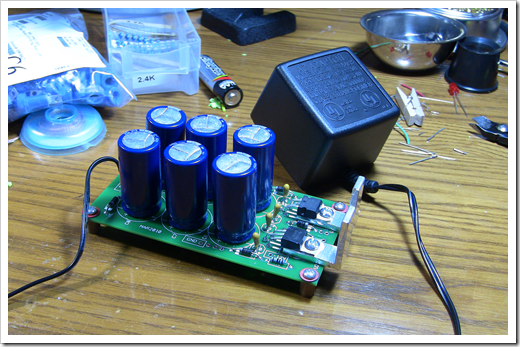
I made some ghetto heat sinks from aluminum angle. The Al was a
bit thicker than made sense for this operation, so I had to bend
the 7812/7912 leads down at an odd angle. It worked, though.
They're attached with screws and non-conductive thermal grease. I'm
not sure how necessary the heat sinks will be given the voltages
being fed in, but I don't like to go without. The reason I made
those instead of picking some up is because almost every commercial
TO-220 heat sink I've seen is wide enough to short to the pads in
between the two regulators. Also, as Ray points out on his site,
the two regulators can't share a heat sink as they aren't both at
ground potential. I may have been able to finagle something by
standing the regulators up, but space is pretty tight in there as
you can see:
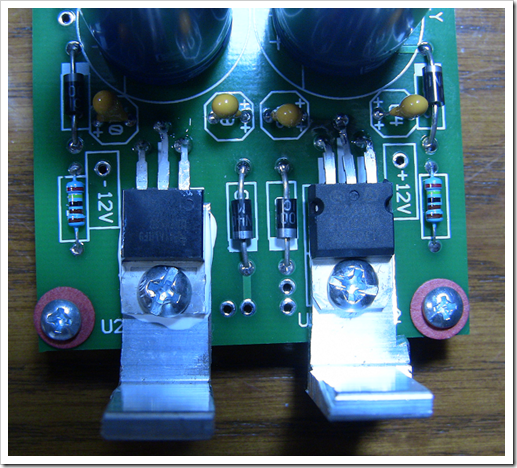
I do have to admit to a tiny bit of fear when I plugged it in. I
double checked everything, and checked for continuity between
points where I wouldn't want any. Still, let's just say that I kept
my face away from the capacitors when plugging it all in :)
Here I'm testing for +12v
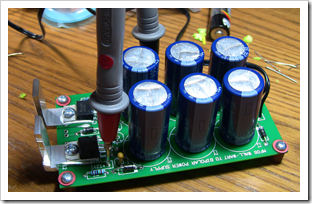
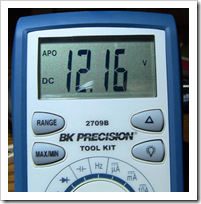
And here I'm looking for -12v
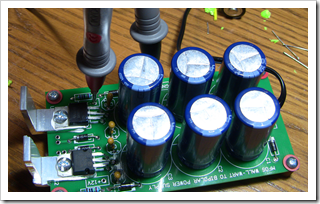
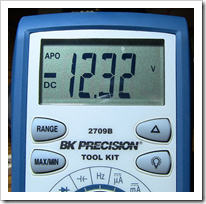
The values are fine; you're not typically going to get perfect
voltages using a power supply like this. It could also have to do
with the quality of the LMs I'm using. If I took time to test a
bunch I could probably get this a lot closer to +/- 12v, but it's
likely not worth the trouble. I'll double-check with Ray just in
case.
My potentiometers shipped today, so I'll likely work on the
front panel for the synth after I return from VSLive next week.
